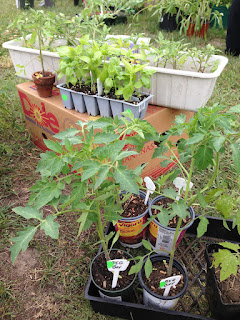A sampling of our seasonal tips & advice... click on the Garden Guru link under the Labels section (bottom right) for more great information!
SPRING
Spring-cleaning Your Houseplants and Starting Seeds
Here are a few ideas for gardening now. It's a good time to clean the dust off your houseplants. The coating can inhibit the exchange of air and moisture for the plants. With smooth leaved plants, you can just wipe them with a damp sponge or moist paper towel. For plants that have textured or fuzzy leaves, take a clean paint brush or even a make-up brush and whisk away the dust.
If you are starting seeds indoors, try to water them from the bottom. Watering from above can dislodge the seeds or even knock down a tender seedling. Set the flat or pot into a larger container and pour the water into that and let the seeds absorb what they need from that. Just don't leave them in standing water for more than a few minutes.
Happy spring, and keep a look-out for those first crocus, or flowers on a hellebore, the plant also known as a Lenten rose because it can blossom as early as Lent.
Glad Tidings
If you have grown glads in the past you've probably noticed that they all bloom about the same time, last for a week or so and that's it. If you'd like to have glads blooming most of the summer, the trick is to plant them over the course of a month or so. With successive plantings, you would plant 8-12 bulbs one week, then another group a week later and another group a week or so after that.
Plant the bulbs (or more correctly the corms) in full sun in well drained soil. If you plant early in the season they will take 8-10 weeks to flower, but if you plant in warmer weather (June), glads will bloom in 6-8 weeks. They come in so many beautiful colors, I hope everyone will give them a try this year.
Cut back perennials that have finished blooming. They’ll look neater and many will surprise you with a second bloom when prevented from setting seed the first time.
We immediately think of mums, but there are also ornamental kales and cabbages for sale. They are hardy even after frost and as temperatures drop, their colors often get deeper.
Many garden centers have perennials, shrubs and trees on sale at this time so take advantage of lower prices and add more life to your garden.
SUMMER
Garden Maintenance Tips for August
Cut back perennials that have finished blooming. They’ll look neater and many will surprise you with a second bloom when prevented from setting seed the first time.
Keep picking your vegetable gardens. By picking, you are preventing your plants from going to seed so they keep producing. If you have more vegetables than you can use, offer it to friends or call a local food pantry and ask for their drop-off days.
Replant this month for a more bountiful fall crop: green beans, peas, cucumbers, carrots, kohlrabi, summer squash, early sweet corn, green onions. Water seeded areas by hand daily until the new plants are up and a couple of inches tall. Cover the newly planted seeds with row covers to help keep them cooler and out of pecking range of birds. You can take the row covers off when the plants are several inches tall.
Fall
Fall Plantings
Many garden centers have perennials, shrubs and trees on sale at this time so take advantage of lower prices and add more life to your garden.
And of course, autumn is the time to plant tulip and daffodil bulbs for color next spring. And remember the smaller bulbs like crocus, grape hyacinth and snowdrops which are the first to pop in early spring.
-MJ





No comments:
Post a Comment